How, when and with what to spray apple trees in the spring against pests and diseases
The apple harvest is the pride of any gardener. It is impossible to take your eyes off the blossoming apple trees and the branches hanging under the weight of fruits. But talking about the benefits of these fruits, perhaps, would be superfluous.
In order for apple trees to bear fruit abundantly, they need care and preventive measures throughout the season, especially in spring. At this time of year, trees are most susceptible to diseases and pests. Spring treatment is one of the most important stages of care. Let's talk about this in more detail.
Goals of spring processing of apple trees
Spring care for apple trees involves a set of various measures, which includes pruning, fertilizing, whitewashing, and tree protection.
The main purpose of treatment is to protect plants from fungal diseases and pests. Many insects overwinter on the branches of apple trees in the egg stage, so they begin to treat trees in early spring. Thanks to correct and timely spring processing, there will be less work in the summer.

What pests threaten apple trees?
Insects cause a lot of harm to crops. They eat leaves or suck out their juice, spoil the bark and roots of the tree, destroy buds, ovaries and buds.
Depending on the nature of the damage, insects are divided into gnawing and sucking.
The main pests of apple trees:
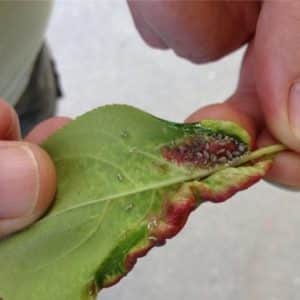
- codling moth. One of the most dangerous pests of apple trees. This is a nocturnal grayish-brown butterfly with a wingspan of 20 mm. During the day she hides in the treetops.A week after the apple trees begin to bloom, the insect lays eggs on the upper side of the tree leaf. Codling moth caterpillars are light pink with gray warts on the body, up to 18 mm long. They lay wormholes through the entire apple, and within 25-30 days after flowering a carrion appears.
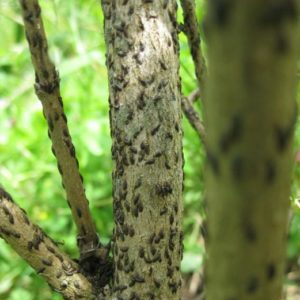 Apple comma scale. The color of the scutes matches the bark of the trees, and their shape resembles commas. The size of the shields is 2-4 mm. Under the scutes there are flat yellowish insects. Insect eggs are also stored under the shields for the winter. The scale insect feeds on the sap of young branches and bark.
Apple comma scale. The color of the scutes matches the bark of the trees, and their shape resembles commas. The size of the shields is 2-4 mm. Under the scutes there are flat yellowish insects. Insect eggs are also stored under the shields for the winter. The scale insect feeds on the sap of young branches and bark.- Aphid. Insects up to 2 mm in size are brown or green. Eggs are laid for the winter near the buds on young branches. Aphids damage the tops of young shoots of apple trees and their leaves. After infection by aphids, the leaves curl and dry out, and the branches stop developing.
- Leaf roller. Green caterpillars, up to 2 cm long, gnaw the skin of apples, roll and gnaw leaves.
- Apple flower beetle (weevil). Beetles up to 7 mm long have a long proboscis. The weevil eats the pistils and stamens of the buds and glues the petals together.
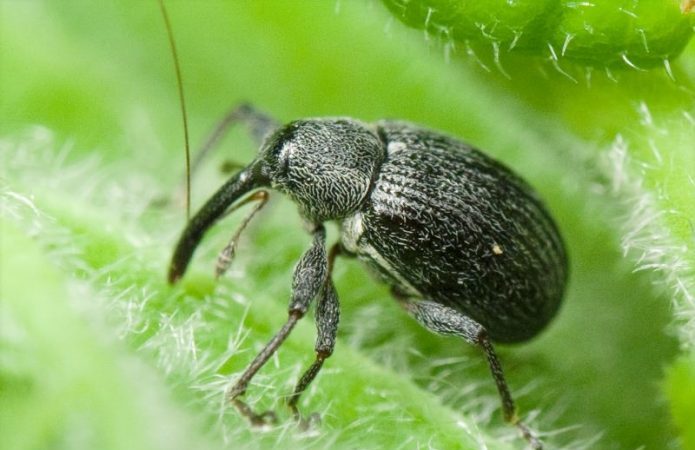
- Apple moth. The butterfly develops from yellowish caterpillars up to 2 cm long. The insect settles in trees in colonies. The caterpillars eat young leaves and envelop the apple tree with cobwebs, forming cobweb nests.
- Red apple mite. It is up to 0.4 mm long and bright red in color. Due to its small size, it is difficult to notice on an apple tree. The mite lives on the underside of leaves and forms a thin web there. Arthropods move along it. The mite infects the leaves, which first darken and then dry out.

What diseases
It's not just insects that harm the apple crop. The culture is susceptible to various diseases and fungal infections.They are easily recognized by the appearance of the trees and fruits.
Common diseases of apple trees:
- Black cancer. One of the most dangerous diseases caused by fungal infections. It first forms brown spots on the bark and branches of trees, then darken and become depressed. Gradually, the spots increase in size and turn black. The bark begins to die and crack. The disease causes the death of the trunk and branches and affects older apple trees more. Affected branches are usually removed.
- Scab. A dangerous disease that affects leaves and fruits. It is caused by a fungus of the genus Venturia inaequalis. It becomes active at high air humidity and first affects young shoots, and then spreads to the rest of the tree. It appears as dark spots on the leaves at the end of flowering, which increase in size and then merge. After this, the leaves fall off. Spots covered with a green velvety coating also appear on young fruits. The fetal tissue in the affected areas cracks and hardens.
- Mold. Also caused by fungal infections that get into wounds on the tree bark. Mold appears as gray-greenish spots on the bark. Fungi multiply very quickly and affect a significant part of the integument.
- Moniliosis (fruit rot). This fungal disease is caused by insect pests. The fruits first become soft, then begin to rot. Rot also affects young shoots.
This is interesting:
How and with what to spray currants in the spring against pests and diseases
How to treat currants and gooseberries in the spring against pests and diseases
Pests and diseases of honeysuckle: signs of damage and methods of combating them
Processing times
Spring processing of apple trees is carried out in several stages.
First treatment can only be carried out when the snow has already melted. In this case, the air temperature should not fall below +5°C. It is also necessary to carry out the first treatment before the buds swell.
Second Once the culture is processed at a temperature from +10 to +15°C. At this time, the buds swell and insect pests begin to awaken.
third the treatment is carried out when the apple tree bud is already there, but has not yet opened. This is the time of awakening of the codling moth. The treatment prevents the moth from laying eggs.
The last one – fourth – treatment is carried out after flowering. This is the time of formation of ovaries. Codling moth and moniliosis are also dangerous at this time.
Important! It is not recommended to treat apple trees immediately after flowering. Treatment begins after 10-15 days.
Preparatory activities
Before treating apple trees for pests, they need to be prepared.
After winter, trees may become damaged and the bark may peel off in places. The tree is inspected and the old bark is cleaned. Minor damage is treated with garden varnish. Traces of frostbite are cut down to living tissue and treated with an antiseptic.
The bark of young trees can get sunburned, so apple trees younger than ten years old are whitened with lime or garden acrylic paint.

Important! Old tree bark is peeled off after rain.
An important stage - spring pruning. It rejuvenates old trees, shapes the crown, and regulates fruiting function. Remove dry and damaged branches to the living area and cover with garden varnish. Young seedlings are left with the most powerful skeletal branches.
What to process
To protect apple trees and get a bountiful harvest, you need to know what to spray apple trees against pests and diseases in the spring. There is no shortage of funds now. The main thing is to choose them correctly and follow the instructions.Gardeners use biological and chemical means, as well as folk methods.
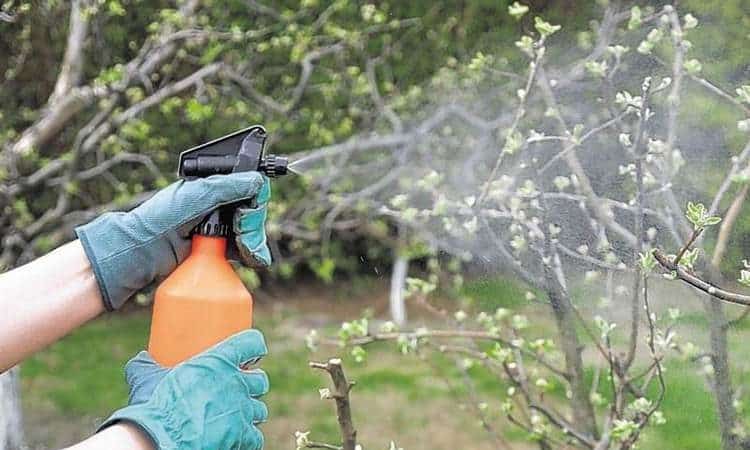
Purchased chemicals
Chemical drugs act faster than others, but require precise dosage. Exceeding it harms plants. Apple trees need to be sprayed with chemicals before the sap begins to flow.
Effective chemicals:
- Urea (urea). Destroys leaf rollers, aphids, fungal diseases. Fills the soil with nitrogen. By the time the juices move, the products of urea treatment should have evaporated. For 10 liters of water, 20-30 g of urea is required.
- Copper sulfate. Apple trees are treated with products containing copper once a year. Dilute 100 g of vitriol crystals in 10 liters of water.
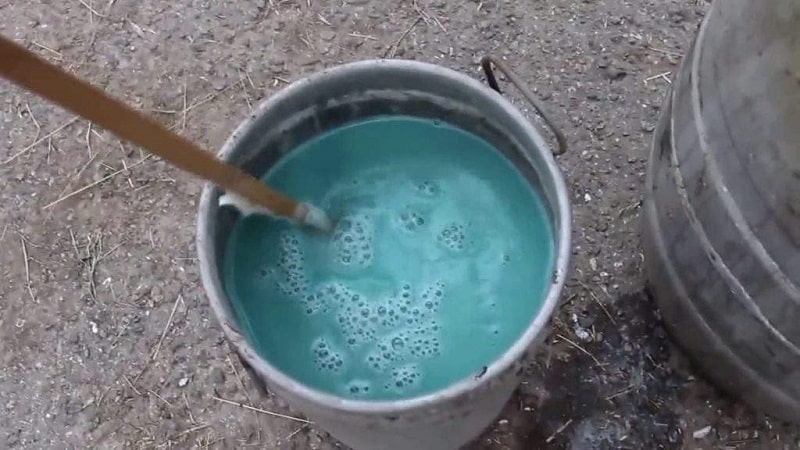
- Bordeaux liquid. Destroys the larvae of most pests. The product contains copper. Bordeaux mixture is one of the best preventive remedies against apple tree diseases. For preparation, use 300 g of copper sulfate and 400 g of quicklime per 10 liters of water.
- Colloidal sulfur. An excellent anti-tick product. 80 g of sulfur is stirred in 10 liters of water to form a suspension.
- inkstone. A universal remedy that destroys insects and protects against fungal diseases. Preparation: 500 g of vitriol per 10 liters of water.
Biological agents
Biological products are created on the basis of viruses and bacteria that destroy insects and fungal diseases.
Main biological products:
- "Agrofit" destroys moths, codling moths and aphids;
- "Planriz" – one of the most universal remedies that affects both diseases and insects;
- "Gaupside" effectively affects fungal diseases;
- "Pentaphage-S" used for the prevention and treatment of apple trees from black cancer;
- "Bictoxibacillin" – the drug is effective due to its effect on the digestive system of insect pests, they die very quickly.
Experienced gardeners recommend using a mixture of biological products for spraying. Spray with this solution at an air temperature of at least +10°C. Lower temperatures reduce the effectiveness of the solution.
Important! Before spraying apple trees, you need to know the weather forecast for 1-2 days ahead. If it rains during this period, the effect will be minimal.
Traditional methods
Folk remedies are used mainly to control pests that destroy foliage and to combat diseases.
Common folk methods:
- Garlic. Prepare an infusion in the following proportions: pour 1 kg of garlic into 10 liters of water and leave for two hours.
- Pepper infusion. 100 g of hot pepper is poured into 1 liter of water and boiled for two hours. Next, filter and add water to 10 liters.
- Camomile tea. 700 g of dried chamomile is poured into 5 liters of boiling water and left for 10 hours. Add water to 10 liters and dissolve 50 g of laundry soap.
- Soda. For 10 liters of water take 70 g of soda and 20 g of liquid soap.
How to properly process apple trees in spring
Many people underestimate the danger of chemicals that are used to spray apple trees, use ineffective means of protection or do without them at all. Such carelessness can cause significant harm to health, so precautions must be taken when processing trees.
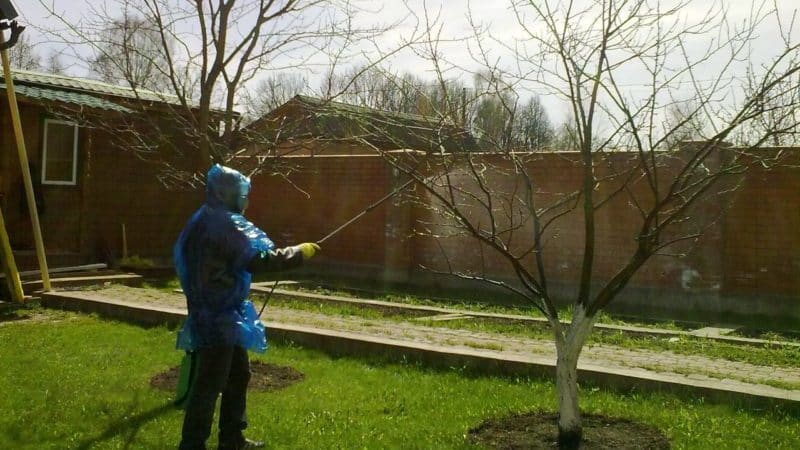
Precautionary measures
There are a number of necessary measures that everyone must follow when spraying trees:
- preparations for treatment are prepared strictly according to the instructions;
- spray apple trees only in calm weather;
- use personal protective equipment: special clothing, respirator, goggles, gloves.
Further care
After spraying, the soil under the apple trees is dug up in a circle around the trunk. This is the diameter of the widest part of the crown. Dig to the depth of the spade pin, removing the roots of weeds.
Many regions experience late spring frosts. At the same time, the ovaries and flowers of apple trees suffer the most.
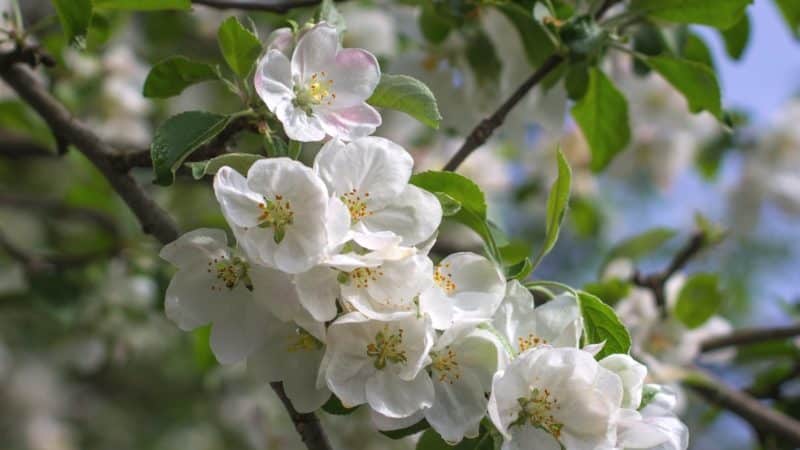
Apple trees are protected from frost mainly in two ways:
- Smoke. Fires are lit on the leeward side of the site. The material in the fire only needs to smolder to produce smoke. For these purposes, sawdust, last year's leaves, and shavings are used.
- Water. Up to 60 liters of water are poured under each mature tree.
This is interesting:
What to do if rust appears on honeysuckle leaves and how to treat it
Conclusion
To grow a bountiful harvest of apples, you will have to work hard in the spring. No matter how hardy the apple trees are, in the spring they need to be prepared for future fruiting: cleared of old branches and bark, trimmed off excess branches, carefully treated against possible diseases and harmful insects, fed and watered. With proper care, apple trees will delight you with a rich harvest, and in winter there will always be delicious jam, juice and pies on the table.
Please tell me how to protect apple trees from rodents? Last year the mice gnawed all the apple trees. What to do?